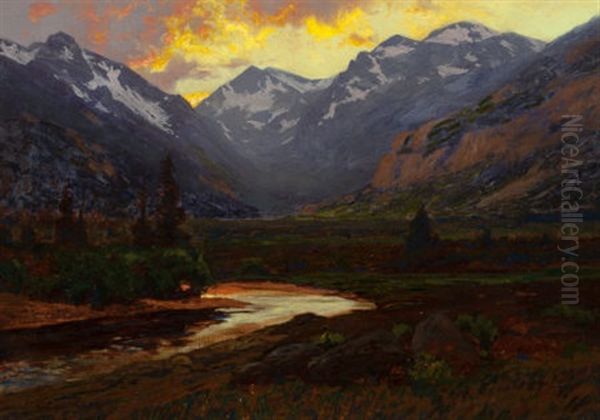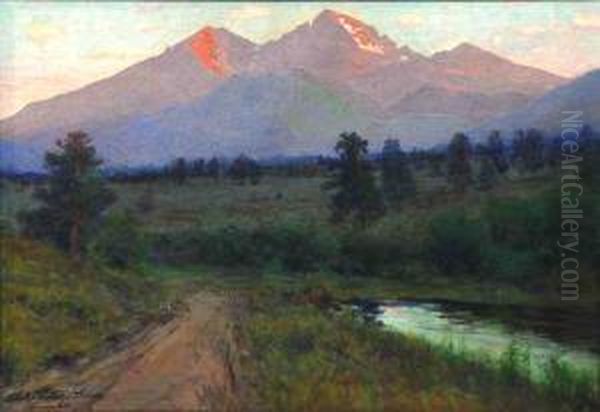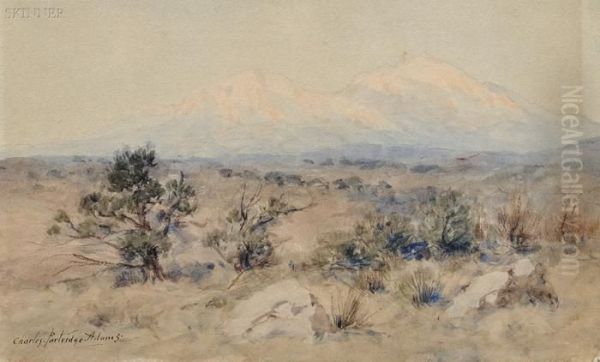Charles Partridge Adams stands as a significant figure in American landscape painting, particularly renowned for his evocative depictions of the Colorado Rocky Mountains. Active from the late 19th century through the early 20th century, Adams dedicated much of his prolific career to capturing the unique light, atmosphere, and grandeur of the American West. Though largely self-taught, his keen observational skills and evolving style, which transitioned from detailed realism towards a more impressionistic approach, allowed him to create a lasting visual record of Colorado's natural beauty, earning him a distinguished place in the history of Western American art.
Early Life and the Journey West
Born in Franklin, Massachusetts, in 1858, Charles Partridge Adams displayed an early inclination towards art. His formative years were spent in New England, but a pivotal change occurred in 1876 when his family relocated to Denver, Colorado. This move, like that of many others during the era, was partly motivated by health concerns, seeking the drier climate of the West. Denver, at the time, was a burgeoning city, rapidly transforming from a frontier town into a significant urban center, providing a dynamic backdrop for the young aspiring artist.
The Colorado landscape immediately captivated Adams. The vast plains rolling up to meet the dramatic peaks of the Rocky Mountains offered endless inspiration. This environment, starkly different from the gentler scenery of Massachusetts, would become the central focus of his artistic life. Arriving in his late teens, Adams was poised to absorb the spirit of the West and translate its unique character onto canvas.
Artistic Formation: A Path of Self-Discovery
Unlike many prominent artists of his time who sought formal academic training in the established art centers of the East Coast or Europe, Charles Partridge Adams was primarily self-taught. His artistic education was a process of personal exploration, diligent practice, and learning through observation and interaction with other artists. He possessed a natural talent, but honed his skills through relentless sketching and painting directly from nature, a practice known as plein air painting.

Despite his self-reliance, Adams did seek guidance and inspiration from established figures. He is known to have visited the studios of influential American landscape painters such as George Inness, whose Tonalist style, emphasizing mood and atmosphere through subtle color harmonies, likely resonated with Adams' own sensitivity to light. He also interacted with William Keith, a prominent California landscape painter known for his romantic and often dramatic depictions of the Sierra Nevada mountains. These encounters, though perhaps brief, would have exposed Adams to different artistic philosophies and techniques.
In Denver, Adams found a more direct, albeit informal, mentorship figure in Helen Henderson Chain. Chain was a formally trained artist who had studied with George Inness herself. She established a studio in Denver and was known for leading sketching trips into the mountains, providing instruction and fostering a local art community. Adams benefited from her guidance and the opportunity to work alongside a trained professional, particularly in the techniques of outdoor painting. This early association was crucial in shaping his foundational skills and confidence.
The Denver Years: Establishing a Reputation
During the 1880s and 1890s, Adams established himself within Denver's growing art scene. He became a professional artist, initially supporting himself through various means, including possibly working with wood engraving, before dedicating himself fully to painting. His commitment and talent quickly gained recognition. In 1893, he became a charter member of the Denver Artists' Club (later the Denver Art Museum), signifying his integration into the city's formal artistic circles.
His association with Helen Chain extended into a professional partnership. Together, they operated a studio and gallery space known as "The Sketch Box." This venture served not only as a place to create and display their own work but also as a commercial outlet, promoting landscape painting and portraiture to the Denver public. Their collaboration proved successful, and Adams' reputation grew steadily. An early accolade came when he won a gold medal for his work submitted to the Denver Exposition, an achievement that validated both his talent and Chain's mentorship.
Throughout his Denver period, Adams tirelessly explored the nearby foothills and mountains. He developed a deep familiarity with the local terrain, the South Platte River valleys, and the ever-changing play of light on the Front Range peaks. His works from this era often exhibit a detailed, realistic style, carefully rendering the geological formations and atmospheric conditions that defined the Colorado landscape. He was building a visual vocabulary that would serve him throughout his career.
Estes Park: The Muse and the Mountain Studio

A significant chapter in Adams' life and career began around the turn of the century, culminating in his move to Estes Park, Colorado, in 1905. Nestled at the foot of the towering peaks that would soon become Rocky Mountain National Park (established in 1915), Estes Park offered Adams unparalleled access to the dramatic high-country scenery that became his signature subject matter. He built a home and studio there, strategically positioned to offer inspiring views, naming this new base, like his earlier Denver venture, "The Sketch Box."
Estes Park became Adams' primary residence and artistic hub for many years. The region, particularly the areas around Longs Peak, Moraine Park, and Bear Lake, provided endless inspiration. He painted these iconic locations repeatedly, capturing them in different seasons, weather conditions, and times of day. His deep connection to this specific landscape is evident in the sensitivity and authenticity of his depictions.
Adams was not alone in recognizing the artistic potential of Estes Park. He played a role, alongside figures like R.H. Tallant, in fostering an artists' community in the area. During the 1920s and 1930s, Estes Park became a magnet for artists drawn to the majestic scenery. Adams, along with the distinctive Swedish-American painter Birger Sandzén, known for his bold colors and expressive brushwork, and the artist Dave Stirling, became central figures in this burgeoning art colony. Their presence helped solidify Estes Park's reputation as an important center for landscape painting in the West.
Evolving Style: From Realism to Impressionism
Charles Partridge Adams' artistic style was not static; it evolved considerably over his long career. His earlier works, influenced by the prevailing tastes and perhaps his initial studies, often demonstrate a commitment to detailed realism. He meticulously rendered topographical features, tree lines, and rock formations, aiming for accuracy in representation. This approach aligned with the traditions of earlier American landscape painters, including some members of the Hudson River School like Albert Bierstadt and Thomas Moran, who had documented the West's grandeur, albeit often on a more epic and sometimes romanticized scale.
However, as Adams matured artistically, his style loosened, absorbing influences from Tonalism and, more significantly, Impressionism. While he never fully adopted the broken color techniques of French Impressionism, his work increasingly emphasized the effects of light and atmosphere over precise detail. His brushwork became more visible and expressive, and his color palettes grew richer and more vibrant, particularly in capturing the fleeting effects of dawn, dusk (alpenglow), and changing weather.

He became particularly adept at capturing the unique atmospheric conditions of the high Rockies – the clarity of the air, the intensity of the sunlight, the dramatic cloud formations over peaks, and the deep, cool shadows. He often employed the alla prima (wet-on-wet) technique, allowing him to work quickly outdoors and capture the transient moments of light and color before they shifted. This shift towards a more impressionistic sensibility aligned him with broader trends in American art, where artists like Childe Hassam and Theodore Robinson were adapting Impressionist principles to American subjects, though Adams developed his own distinct regional interpretation.
Adams worked proficiently in both oil and watercolor. His field sketches, often executed in blue ink or pencil with detailed notations, served as studies for larger studio paintings but also stand as accomplished works in their own right, revealing his process of observation and composition. His later works, while still grounded in the reality of the landscape, convey a powerful sense of mood and place through painterly means.
Subject Matter: Colorado and Beyond
The heart of Charles Partridge Adams' oeuvre lies in the Colorado Rockies. He painted the iconic peaks – Longs Peak, Mount Meeker, the Never Summer Range – with an intimacy born of long familiarity. Moraine Park, with its meandering river and panoramic mountain backdrop, was a recurring and favorite subject, immortalized in one of his most famous paintings, Moraine Park (c. 1895). He captured the dramatic beauty of snow-capped summits under brilliant blue skies, the turbulent energy of approaching storms, and the serene glow of twilight settling over the valleys.
While Colorado was his primary muse, Adams' artistic explorations were not confined to a single state. Seeking fresh perspectives and diverse landscapes, he traveled and painted extensively throughout his career. His journeys took him east to New Hampshire, where he painted scenes like Mill Near Plainfield, and north to New Brunswick, Canada. He ventured west to Nevada's Lake Tahoe and explored the natural wonders of Yellowstone National Park, a landscape famously depicted by Thomas Moran.
Later in his life, Adams spent considerable time in California. He painted the coastal scenes and the rolling hills, engaging with the landscapes that inspired the California Impressionists. His travels provided him with a broader range of subjects and likely exposed him to different artistic currents, enriching his overall body of work. However, it is his profound connection to and interpretation of the Colorado mountains for which he remains most celebrated.
Signature Works and Recognition
Over his nearly fifty-year career, Charles Partridge Adams produced a vast number of paintings. Several works stand out as particularly representative of his style and subject matter:
Moraine Park (c. 1895): Perhaps his most iconic painting, this work captures the expansive beauty of Moraine Park in Estes Park, with the Big Thompson River winding through the meadow towards the distant mountains. It exemplifies his ability to balance detailed observation with atmospheric effect.
Longs Peak Sunset (or Twilight over Longs Peak, variations exist): Adams painted Longs Peak countless times, often focusing on the dramatic light effects of sunrise and sunset. These paintings showcase his skill in rendering the alpenglow phenomenon, where mountain peaks are bathed in rosy light, using rich colors and expressive brushwork.
Spanish Peaks (c. 1900): Depicting the distinctive pair of mountains in southern Colorado, this work often shows his move towards a more impressionistic handling of paint and color, capturing the essence of the scene with greater freedom.
In the Vicinity of Ouray: Paintings of the San Juan Mountains in southwestern Colorado, known for their ruggedness and mining history, demonstrate his ability to capture the specific character of different mountain ranges within the state.
Trees in Autumn (c. 1900): Adams excelled at depicting the vibrant colors of Colorado's autumn, particularly the golden aspens set against evergreen forests and blue skies. These works highlight his sensitivity to seasonal change.
Adams achieved considerable recognition during his lifetime. He exhibited widely, not only in Denver but also in major exhibitions in cities like Chicago, St. Louis, and Omaha. His work was acquired by collectors and institutions, solidifying his reputation as one of the preeminent landscape painters of the American West.
Later Life and Enduring Legacy
In his later years, Adams increasingly spent time in Southern California, eventually settling in Laguna Beach, a well-known artists' colony associated with California Impressionism. This move placed him in proximity to artists like William Wendt, Guy Rose, and Edgar Payne, the latter also known for his powerful depictions of mountain scenery, particularly the Sierra Nevada. Adams continued to paint, though perhaps less prolifically than in his prime, until his death in Laguna Beach in 1942.
Charles Partridge Adams left behind a significant legacy. His thousands of paintings provide an invaluable record of the Colorado landscape at a time before widespread development. He captured the spirit of the Rockies with an authenticity and sensitivity that resonated with viewers then and continues to do so today. He was a key figure in the development of art in Colorado, both as a founding member of the Denver Artists' Club and as a central figure in the Estes Park art colony.
His work is held in numerous public and private collections, including the Denver Art Museum, the Kirkland Museum of Fine & Decorative Art in Denver, the Colorado Springs Fine Arts Center, the Anschutz Collection, and the Boston Museum of Fine Arts, among others. His paintings remain highly sought after by collectors of Western American art.
Adams in the Context of American Art
Placing Charles Partridge Adams within the broader context of American art history reveals his unique position. He bridged several movements. His early realism connects to the documentary impulse seen in some later Hudson River School painters and survey artists. His focus on light and atmosphere aligns him with Tonalism, influenced by George Inness and contemporaries like Alexander Helwig Wyant.
His evolution towards looser brushwork and brighter color palettes clearly shows the influence of American Impressionism. However, Adams was not simply imitating East Coast or European trends; he adapted these stylistic elements to suit the specific light, scale, and character of the Rocky Mountain West, creating a distinctly regional form of landscape painting. He can be seen as a key figure in the development of Western American Art, focusing primarily on the landscape itself, rather than the narrative or genre scenes associated with artists like Frederic Remington or Charles M. Russell. He shared a dedication to depicting the Western landscape with California artists like William Keith and Thomas Hill, but his focus remained firmly rooted in Colorado.
Conclusion: Interpreter of the Mountain Light
Charles Partridge Adams dedicated his life to interpreting the majestic landscapes of the American West, particularly the Colorado Rockies. As a largely self-taught artist, he forged a unique path, developing a style that evolved from careful realism to an expressive, light-filled impressionism. His deep familiarity with his chosen subject matter, combined with his technical skill and sensitivity to atmospheric effects, allowed him to capture the essence of the mountains in a way few others have. Through his prolific output and his role in fostering artistic communities in Denver and Estes Park, Adams made an enduring contribution to the cultural heritage of Colorado and the broader tradition of American landscape painting. His works continue to offer viewers a compelling vision of the timeless beauty of the Rocky Mountain West.